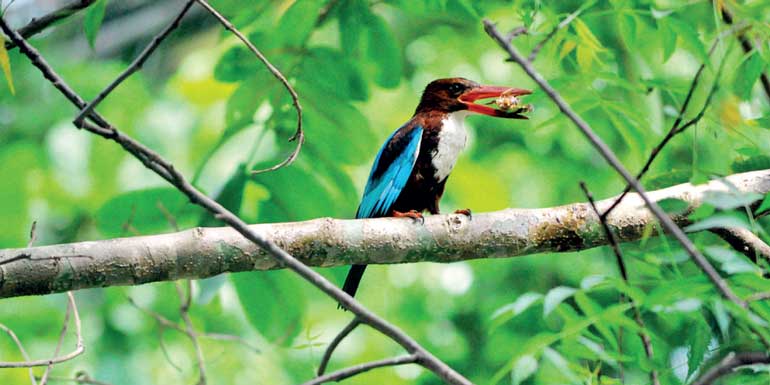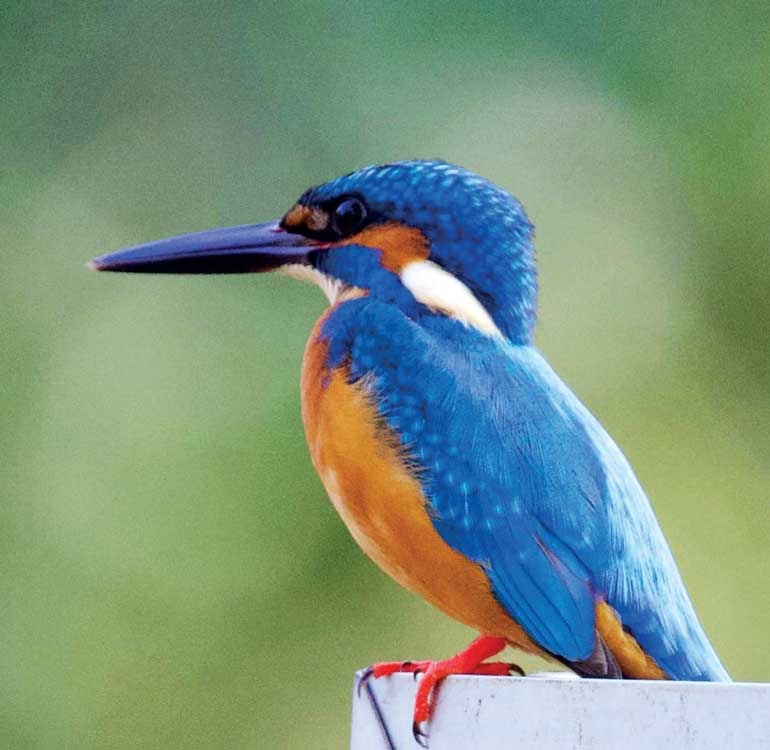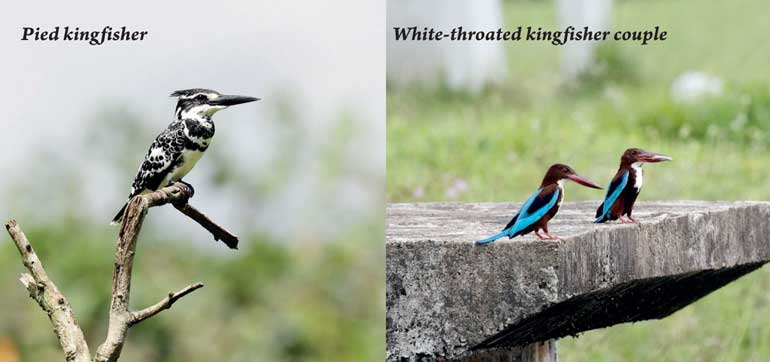Sunday Apr 20, 2025
Sunday Apr 20, 2025
Saturday, 1 April 2023 00:01 - - {{hitsCtrl.values.hits}}

White --throated kingfisher with its catch
Common kingfisher
Text and pix by
Chandani Kirinde
What bird photographers most crave for are shots of birds with vibrant colours and one such species of birds are kingfishers. Several species of kingfishers can be easily spotted in urban dwellings as they are well adapted to the sounds and sights of human dwellings. The three kinds of kingfishers most seen in urban areas are the white-throated kingfisher, the common kingfisher and the pied kingfisher. If you live in an area with good tree cover and are close to water bodies, these birds are impossible to miss.
The bird’s name is self-descriptive. It truly is a king at catching fish while it also feeds on crabs, molluscs, insects, etc. If you keep a close eye on a kingfisher, you can easily observe its routine as it prepares to catch its prey. The white-throated kingfisher and the common kingfisher have similar hunting habits. They sit on low overhanging branches over a water body or on stumps or remains of charred trees near water and wait for a long period of time, sitting in meditative pose, till they spots their catch. They then do a quick, sharp dive and return to the same branch, with their prey, or otherwise returning to their base and continuing with the drill till they succeed. When it catches a small crab or molluscs, the kingfisher hammers it against hardwood on a branch and devours it once it’s dead.
The pied kingfisher’s methods of catching its prey are very different from these two kingfishers. This black and white bird hovers over water from a height of 25 to 30 feet and makes a sharp drive when it spots its prey, hitting the water with a splash. If it’s not successful on the first try, it flies up again and returns to its position high above the water, before making another dive. Once a catch is in its beak, the pied kingfisher makes its way to a tree branch or another safe location to enjoy its meal. The white-throated kingfisher and the common kingfisher are easiest to observe closely and photograph when they perch on branches and wait for a long period of time to get their next meal. They are habitual, coming back to the same branch day after day. The white-throated kingfisher lays its eggs in holes in embankments and one can see them fly to and from such places feeding the young. I have yet to observe the breeding patterns of the other two kinds of kingfisher I have mentioned.
The common kingfisher, the tiniest of the three birds I’ve mentioned, has a habit of bobbing up and down when it sits and waits for its catch. Though it’s called the common kingfisher, it’s not as common as the white-throated kingfisher.
The pied kingfisher on the other hand is a bit of a rarity even though I have spotted them on several occasions hovering high above the water. It’s more difficult to find them perched on branches or wires.
The stork-billed kingfisher, a larger bird with a longer beak, too is found in urban areas and while I have spotted it a few times, I have not been able to photograph it so far.
Kingfishers are among the easiest birds to observe and photograph for beginners. So, if you are eager to see and photograph kingfishers, look out for them in your neighbourhood. It’s unlikely you’ll miss their vibrant colours and distinct calls.
Note: White-throated Kingfisher (Gelasudu Medi Pilihuduwa in Sinhala, Ven Thondai Meenkothi in Tamil), Common Kingfisher (Mal Pilihuduwa (S), Siru Neela Meenkothi (T)), Pied Kingfisher (Gomara Pilihuduwa (S) Karuppu Vellai Meenkothi (T)), Stork-billed Kingfisher (Mahathudu Mal Pilihuduwa (S), Periya Alahu Meenkothi (T)).

Discover Kapruka, the leading online shopping platform in Sri Lanka, where you can conveniently send Gifts and Flowers to your loved ones for any event including Valentine ’s Day. Explore a wide range of popular Shopping Categories on Kapruka, including Toys, Groceries, Electronics, Birthday Cakes, Fruits, Chocolates, Flower Bouquets, Clothing, Watches, Lingerie, Gift Sets and Jewellery. Also if you’re interested in selling with Kapruka, Partner Central by Kapruka is the best solution to start with. Moreover, through Kapruka Global Shop, you can also enjoy the convenience of purchasing products from renowned platforms like Amazon and eBay and have them delivered to Sri Lanka.
Discover Kapruka, the leading online shopping platform in Sri Lanka, where you can conveniently send Gifts and Flowers to your loved ones for any event including Valentine ’s Day. Explore a wide range of popular Shopping Categories on Kapruka, including Toys, Groceries, Electronics, Birthday Cakes, Fruits, Chocolates, Flower Bouquets, Clothing, Watches, Lingerie, Gift Sets and Jewellery. Also if you’re interested in selling with Kapruka, Partner Central by Kapruka is the best solution to start with. Moreover, through Kapruka Global Shop, you can also enjoy the convenience of purchasing products from renowned platforms like Amazon and eBay and have them delivered to Sri Lanka.